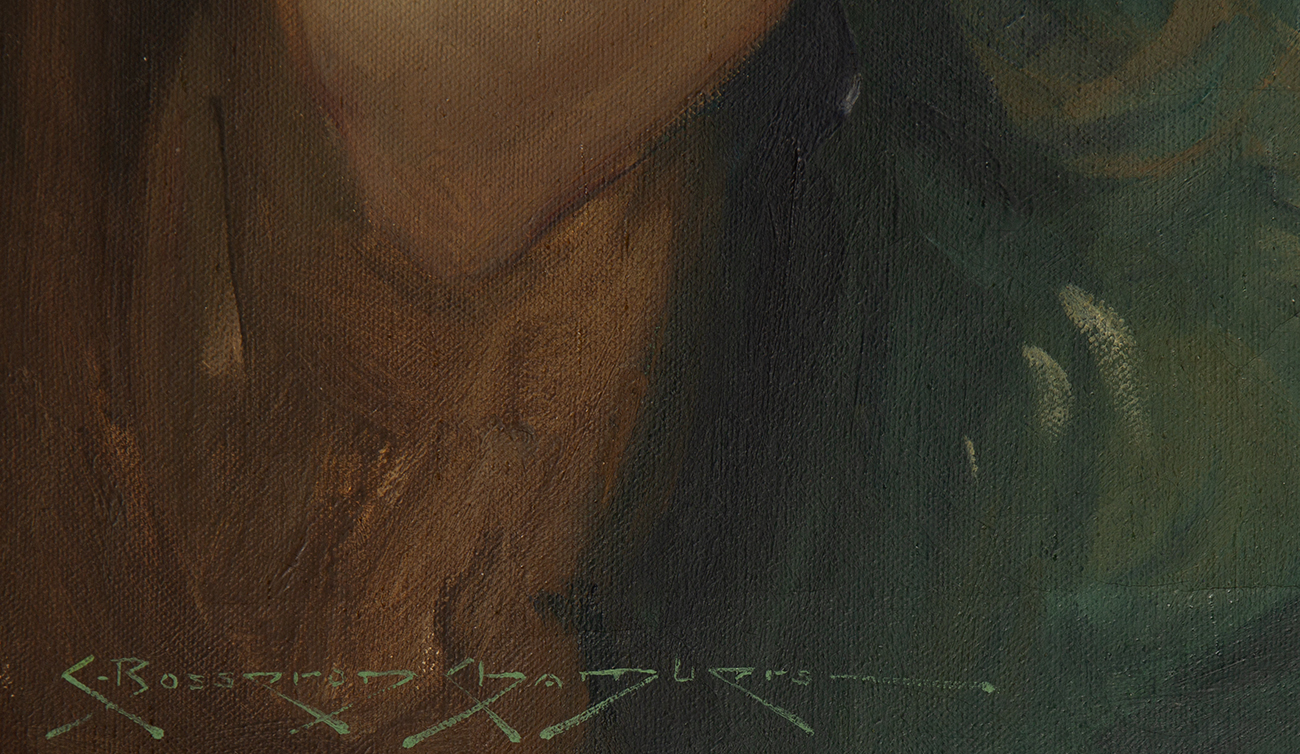
Illustrative advertising portrait by Charles Bosseron Chambers
This gorgeous, oil on canvas painting is by American artist and illustrator Charles Bosseron Chambers. With striking greens and blues popping against a rich, textured background, this illustrative advertising portrait features an elegant rosy-cheeked flapper in a green peacock dress and holding a dainty gold handled mirror. With all the style and glamour of the Jazz Age, this sophisticated flapper girl was used in a published advertisement for Walk-Over Shoes.
The painting is signed by the artist in the bottom left corner and is housed in a vintage carved, gold painted wood frame. The painting is in excellent original condition, in a handsome complimentary wide profile gold frame.
A vintage Walk-Over Shoes printed advertisement is included in the sale.
This painting comes from the collection of esteemed illustration art collector Norman Platnick.

About the artist: Charles Bosseron Chambers
C. Bosseron Chambers was known for figurative works in an illustrative manner, with many of them being either portraits or works with religious themes.
An illustrator and teacher as well as painter, Chambers was born in St. Louis, Missouri on May 1882. His father, a young Irish captain in the British Army, was a convert to the Catholic Church, and his mother was the daughter of a French family long established in St. Louis.
Charles, the youngest of several children, was sent to the Preparatory and Grammar Schools connected with St. Louis University in his earliest years, and his education in his chosen art was begun under Louis Schultz of the Berlin Royal Academy, with whom he spent six years. His next master was Aleis Hrdliczka of the Royal Academy of Vienna, and he later studied with Johannes Schumacher of Dresden for six years.
After matriculating at St. Louis University, Chambers began his professional career at Palm Beach, Florida, a place chosen because of his mother’s failing health.
From this period in his artistic productions date the fantastic figure compositions exhibited at the St. Louis Exposition, together with portraits of Colonel Mitchell for the Missouri Historical Society; Joseph Jefferson, the great American actor; young Master Haven; Henry Phipps; Henry M. Flagler; Mrs. Voorhis and others.
In 1916, he moved to New York City, and established himself in the Carnegie Studios, Carnegie Hall, where he occupied a splendid atelier. Here he produced the Light of the World, the most popular religious painting of the early 1900s in the USA.
He was a member of the Society of Illustrators, established in 1901 in New York City, and the Salmagundi Club, an early important art club in New York City. He illustrated Sir Walter Scott’s, Quentin Durward, in the Scribner Classics for Young People.
His work was exhibited at the well-known John Levy Galleries in New York City in the 1930s, and his work is now in several public collections in St. Louis and Chicago, including Chicago’s St. Ignatius’s Church, Missouri Historical Society in St. Louis, and the Osceola Club in St. Augustine, Florida.


The Legacy of Norman Platnick
In his New York Times obituary, Norman Platnick’s son Michael said that his father had three passions in life, his wife Nancy, spiders, and collecting.
Few individuals have the chance to leave a mark like Norm’s in even one field, let alone two. But Norm managed to be both a celebrated scientist, and one of the most influential lay historians of illustration art.
Under his imprint Enchantment Ink, Norm researched, wrote, and published collectors guides to artists like Rolf Armstrong and Earl Christy. We at Grapefruit Moon Gallery rely on these books in our work, and they are now all freely available as PDFs through the Enchantment Ink website.
Norm’s expertise was a gift, his friendship was a treasure, and his legacy is immeasurable. He is missed.


